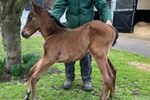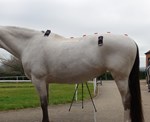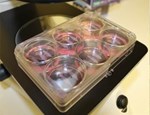Musculoskeletal Biology - Projects
The epidemiology and genetics of congenital musculoskeletal disorders in neonatal Thoroughbreds
The project aims to investigate the contributions of gestational exposures and genetic variants to the risk of congenital developmental orthopaedic disorders (cDOD) in Thoroughbred foals.
The project will provide novel insights into the development, incidence and genetic basis of cDOD in Thoroughbred foals. The project outputs will inform evidence-based management modifications for Thoroughbred breeders to reduce the risk of cDOD in foals and improve broodmare fertility and welfare long-term.
Back movement in the horse: what is normal in relation to age, breed and use?
This study aims to provide fundamental data on the association between equine movement asymmetry and back movement in relation to age, breed and use.
The results will be relevant to equine clinicians, farriers, physiotherapists and other equine paraprofessionals, owners and sports/working horse associations.
Understanding the genetic basis of catastrophic bone fracture in Thoroughbred horses using stem cells.
Bone fractures are a significant welfare problem in the Thoroughbred racing industry. Previous work has demonstrated that fracture is a complex condition with both environmental and genetic factors risk factors. However, the specific genetic factors that underpin fracture risk have not been identified. This has proved problematic to work out using patients due to the difficulty in accessing bone tissue and the large variability in exposure to environmental risk factors.
Using pluripotent stem cells to improve tendon regeneration in horses
Tendon injuries are common in horses taking part in a wide range of disciplines. After an injury, adult tendons undergo poor natural regeneration, instead repairing with functionally inferior scar tissue which leads to high re-injury rates.
Improving tendon regeneration is therefore key to reducing re-injury rates and enabling more horses to return to work following an injury.
How Mosquitos Avoid Obstacles in the Dark
Nocturnal mosquitoes navigate in the dark without crashing into surfaces. When they land on humans or other animals to feed, they do it very gently in order to remain stealthy – being noticed could spell disaster. Since these nocturnal mosquitoes cannot see what they are doing with their eyes, they use a different sensory mode – mechanosensing.
Bird wings act as a suspension system that rejects gusts
Scientists from the Royal Veterinary College (RVC) and the University of Bristol have discovered how birds are able to fly in gusty conditions – findings that could inform the development of bio-inspired small-scale aircraft.
We thought there might be something birds can teach us about coping with turbulence, so we invited Lily the barn owl, Sasha the tawny eagle, Ellie the goshawk and some of their friends to fly through gusts we made in our laboratory.
High aerodynamic lift from the tail reduces drag in gliding raptors
Scientists from the RVC and the University of Bristol have discovered how birds are able to fly in gusty conditions – findings that could inform the development of bio-inspired small-scale aircraft.
Birds and planes must obey the very same laws of physics, and a wing is a pretty good way to create the aerodynamic force known as Lift which balances the Weight of the animal, or aeroplane, due to the relentless pull of gravity. However, there are several notable differences between the two fliers. Flapping is a way to reorient the wings and the aerodynamic force they produce to propel animals forwards in order to balance drag.
Comparing the Movement of Crocodiles, Alligators and Caiman
RVC experts in the movement of various species have found that different crocodilian species – such as crocodiles, alligators and caiman – have very different tendencies when it come comes to galloping. Those who work closely with crocodilian species, such as in zoos and wildlife centres, had noticed over time that crocodiles, alligators and caimans move in different ways, especially when it comes to galloping – which is generally associated with horses.
DAWNDINOS: Testing the locomotor superiority hypothesis for early dinosaurs
DAWNDINOS is in the final year of a five-year research programme studying the dawn of the age of the dinosaurs. This ERC Advanced Investigator grant-funded project, awarded to Prof. John Hutchinson, seeks to unify evolutionary and biomechanical research by achieving a “functional synthesis” in evolution that causally links the anatomy of extinct dinosaurs and their relatives (archosaurs; “ruling reptiles”) to actual performance.
LOCATE: Locomotion, hunting and habitat utilisation among large African carnivores and their prey
LOCATE: Locomotion, hunting and habitat utilisation among large African carnivores and their prey. The carnivores of the southern African savannah have no domestic counterparts and are at the extremes of performance in terms of speed, agility and strength. They are amongst the most threatened species in the world and yet there is much we do not know about them. At the beginning of this project, we did not know how the predators or their prey achieve the speed and manoeuvring required for the chase, what makes the difference between success and failure in hunting or how far the animals travel in a day or night and many other factors that may influence success and survival.
Biomechanical Research Revealing Elephants Move Like 4x4 Vehicles
The RVC has made a significant contribution to the subject of elephant movement over decades. Researchers have been puzzled about how elephants move since Edward Muybridge first caught their “ambling” gait on film as part of his major contribution (with Etienne-Jules Marey) to the invention of cinematography. Elephants can move somewhat quickly but never leave the ground with all four feet at once. Professor John Hutchinson of the RVC took up the challenge of understanding this decades ago and have been progressing research into it since then, spanning elephant anatomy, growth and locomotion.
Bioelectronics
Bioelectronic medicine, or electroceuticals, is a rapidly developing therapeutic field in which biomedical devices are used electrically to block, record, or stimulate neural activity as an alternative to drugs.
Pharmaceutical and surgical intervention are not always as effective as we would like or desirable, especially in species that are extremely sensitive to drugs, such as horses. Bioelectronic medicine allows us to intervene to help patients without the risks associated with other interventions.












